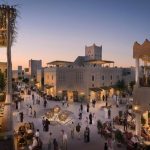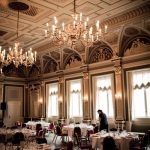King Abdulaziz Historical Center is one of the most popular among Saudi Arabia tourist places and one of the country’s most important cultural and heritage landmarks.
This 440,000-square-metre development was built in 1999 within the Al-Murabba’ Palace Compound in Al-Murabba’ Quarter. It is bordered in the east by King Faisal St, in the north by Al-Delam St., in the west by Jalawi bin Turki St., and in the south by Al-Foutah Garden. Inside the Center are parks and green spaces, cultural facilities and multipurpose amenities with enough parking slots scattered across the vast plot to serve a total of 1,100 cars.
Read on if you are planning to visit King Abdulaziz Historical Center. This guide will tell you more about what you can expect to see and find there.
1. The National Museum
The National Museum is a two-storey 28,000-square-metre building east of the Maydan or the Main Square. The Museum’s thoughtful architecture, courtesy of Architect Raymond Moriyama, is one of its most striking features. Its shape and colour evoke the sand dunes outside Riyadh, while the pointy crescent on the building’s western façade, facing the holy city of Makkah, is a tribute to the Islamic faith.
The Museum has eight main galleries for mainstay exhibits and two supplementary galleries for short-term exhibitions. Every one of the main galleries represents a particular period in the account of man’s journey from the birth of the universe until the present time.
The following are the National Museum’s eight galleries:
- Man and The Universe Gallery
This exhibition tackles four themes: the creation of the universe, fossils, Saudi Arabia’s various environments, and anthropological records on the discovery of man in the Arabian Peninsula.
- Ancient Arabian Kingdoms Gallery
This exhibition provides insight into Arabia in the period between 6000 BC to 400 AD. On display are artefacts from ancient Arabian civilisations, a review of the development of writing from symbolic writing to the first alphabets to primitive writing, reconstructions of the “Taima Wall,” and interactive displays. This gallery also features the succession of early, mid and late period Arabian Kingdoms.
- The Jahiliyyah Gallery
This exhibition shines a spotlight on the Arabian tribes’ customs, traditions, weapons, calligraphy, and other artefacts. It focuses on the pre-Islamic era of the Arabian Peninsula, specifically the period between 400 AD until the advent of Prophet Muhammad, peace and blessings of God be upon him.
- The Prophet’s Mission Gallery
This exhibition showcases the significant events in the life of Prophet Muhammad (P.B.U.H) from his birth until his migration to Al-Madinah. It also highlights his lineage and upbringing.
- Islam and The Arabian Peninsula Gallery
This exhibition picks up where the former gallery leaves off, focusing on the history of the Arabian Peninsula, from the Hijra of Prophet Muhammad (P.B.U.H) up to right before the institution of the first Saudi State. There is a “Dawn of Islam” section focusing on the Islamic State under the Prophet’s reign and another on the era of caliphs.
- The First and Second Saudi States Gallery
This exhibition takes the visitor through the progress of the first and second Saudi states and their leaders. Prominent displays include the military campaign of Ibrahim Pasha, Al-Diriyah (the most prominent town in the first state), the foundation documents of the second state, Imam Turki Bin Abdullah, the declaration of Riyadh as the state’s capital, the succession of Faisal Bin Turki, and pictures of and documentaries about the young King Abdulaziz.
- The Unification Gallery
The exhibition provides insights into the main events that led to the institution of the modern Saudi state and the efforts of the late King Abdulaziz Al Saud to unify the different regions of the state that eventually led to the establishment of the Kingdom of Saudi Arabia. In this gallery, you can watch a documentary on the stages of unification that the Kingdom went through.
- Hajj and The Two Holy Mosques Gallery
This exhibition is all about the Hajj and the Two Holy Mosques’ development and expansion over the years.
2. The Public Park
Lush greeneries comprise the majority (20,000 to 30,000 square metres) of the King Abdulaziz Historical Center’s total area. The Center, therefore, is a beautiful place for a stroll or for communing with nature.
The Maydan, or the Main Square, takes up 20,000 square metres of space right in the middle of the Center. This vast space is designed to be the venue of choice for the city’s social and cultural celebrations.
The Center also has an oasis of palm trees. This feature is located on relatively high ground overlooking the Maydan. The palm tree stands for patience and gratitude. One hundred palm trees were planted to symbolise the 100 years that had elapsed (at that time) since the foundation of the Kingdom.
At the north of the Maydan is a water well, which has been reconstructed from an old well. The well supplies water to a stream that runs across the centre of the Main Square and ends in a man-made lake and fountain.
3. Al-Murabba’ Palace
This is the most historically significant building in the Center. It is part of the original complex of palaces constructed in 1375H at Al-Murabba’ upon the order of the late King Abdulaziz. This Palace is historically significant because it was built to become the ruling family’s residential palace and had hosted many Arab and Islamic dignitaries.
4. The Red Palace
At the southern portion of the Center can be found the Red Palace, which gets its name from its unique red hue. This Palace was the first concrete and steel structure built in Riyadh. It was constructed by order of King Abdulaziz, who bequeathed it to his son, King Saud, in 1984.
After serving as the home of King Saud, the Red Palace became the headquarters of the Council of Ministers and subsequently the seat of the Court of Grievance. Under the purview of The Royal Commission for Riyadh City, the same royal commission responsible for overseeing the design and content of the entire King Abdulaziz Historical Center, it has been turned into a local Riyadh City museum.
Explore King Abdulaziz Historical Center
The National Museum, the vast park, the Al-Murabba’ Palace, and the Red Palace are just a few of the attractions in King Abdulaziz Historical Center. Other places of interest are the King Abdulaziz Library, King Abdulaziz Mosque, King Abdulaziz Auditorium, Water Tower, and Darat Al-Malik Abdulaziz.
If you’re planning to visit King Abdulaziz Historical Center, look up hotels in Saudi Arabia. Best to book a hotel nearby so you can spend a leisurely day sitting among the palm trees, listening to the burble of the water from the old water well, and discovering every inch of the sprawling King Abdulaziz Historical Center.







